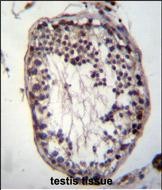PRSS21 Antibody (Center)
Affinity Purified Rabbit Polyclonal Antibody (Pab)
- SPECIFICATION
- CITATIONS: 1
- PROTOCOLS
- BACKGROUND

Application
| WB, IHC-P, E |
|---|---|
| Primary Accession | Q9Y6M0 |
| Other Accession | NP_659206.1, NP_006790.1 |
| Reactivity | Human, Mouse |
| Host | Rabbit |
| Clonality | Polyclonal |
| Isotype | Rabbit IgG |
| Calculated MW | 34884 Da |
| Antigen Region | 165-193 aa |
| Gene ID | 10942 |
|---|---|
| Other Names | Testisin, 3421-, Eosinophil serine protease 1, ESP-1, Serine protease 21, PRSS21, ESP1, TEST1 |
| Target/Specificity | This PRSS21 antibody is generated from rabbits immunized with a KLH conjugated synthetic peptide between 165-193 amino acids from the Central region of human PRSS21. |
| Dilution | WB~~1:1000 IHC-P~~1:10~50 E~~Use at an assay dependent concentration. |
| Format | Purified polyclonal antibody supplied in PBS with 0.09% (W/V) sodium azide. This antibody is purified through a protein A column, followed by peptide affinity purification. |
| Storage | Maintain refrigerated at 2-8°C for up to 2 weeks. For long term storage store at -20°C in small aliquots to prevent freeze-thaw cycles. |
| Precautions | PRSS21 Antibody (Center) is for research use only and not for use in diagnostic or therapeutic procedures. |
| Name | PRSS21 |
|---|---|
| Synonyms | ESP1, TEST1 |
| Function | Could regulate proteolytic events associated with testicular germ cell maturation. |
| Cellular Location | Cell membrane; Lipid-anchor, GPI- anchor |
| Tissue Location | Expressed predominantly in premeiotic testicular germ cells, mostly late pachytene and diplotene spermatocytes |

Provided below are standard protocols that you may find useful for product applications.
Background
This gene encodes a cell-surface anchored serine protease, which is a member of the trypsin family of serine proteases. It is predicted to be active on peptide linkages involving the carboxyl group of lysine or arginine. The protein localizes to the cytoplasm and the plasma membrane of premeiotic testicular germ cells and it may be involved in progression of testicular tumors of germ cell origin. Alternative splicing of this gene results in three transcript variants encoding three different isoforms. [provided by RefSeq].
References
Yeom, S.Y., et al. FEBS Lett. 584(8):1469-1475(2010)
Netzel-Arnett, S., et al. Biol. Reprod. 81(5):921-932(2009)
Kempkensteffen, C., et al. J. Cancer Res. Clin. Oncol. 132(12):765-770(2006)
Manton, K.J., et al. Br. J. Cancer 92(4):760-769(2005)
Clark, H.F., et al. Genome Res. 13(10):2265-2270(2003)
If you have used an Abcepta product and would like to share how it has performed, please click on the "Submit Review" button and provide the requested information. Our staff will examine and post your review and contact you if needed.
If you have any additional inquiries please email technical services at tech@abcepta.com.














 Foundational characteristics of cancer include proliferation, angiogenesis, migration, evasion of apoptosis, and cellular immortality. Find key markers for these cellular processes and antibodies to detect them.
Foundational characteristics of cancer include proliferation, angiogenesis, migration, evasion of apoptosis, and cellular immortality. Find key markers for these cellular processes and antibodies to detect them. The SUMOplot™ Analysis Program predicts and scores sumoylation sites in your protein. SUMOylation is a post-translational modification involved in various cellular processes, such as nuclear-cytosolic transport, transcriptional regulation, apoptosis, protein stability, response to stress, and progression through the cell cycle.
The SUMOplot™ Analysis Program predicts and scores sumoylation sites in your protein. SUMOylation is a post-translational modification involved in various cellular processes, such as nuclear-cytosolic transport, transcriptional regulation, apoptosis, protein stability, response to stress, and progression through the cell cycle. The Autophagy Receptor Motif Plotter predicts and scores autophagy receptor binding sites in your protein. Identifying proteins connected to this pathway is critical to understanding the role of autophagy in physiological as well as pathological processes such as development, differentiation, neurodegenerative diseases, stress, infection, and cancer.
The Autophagy Receptor Motif Plotter predicts and scores autophagy receptor binding sites in your protein. Identifying proteins connected to this pathway is critical to understanding the role of autophagy in physiological as well as pathological processes such as development, differentiation, neurodegenerative diseases, stress, infection, and cancer.



